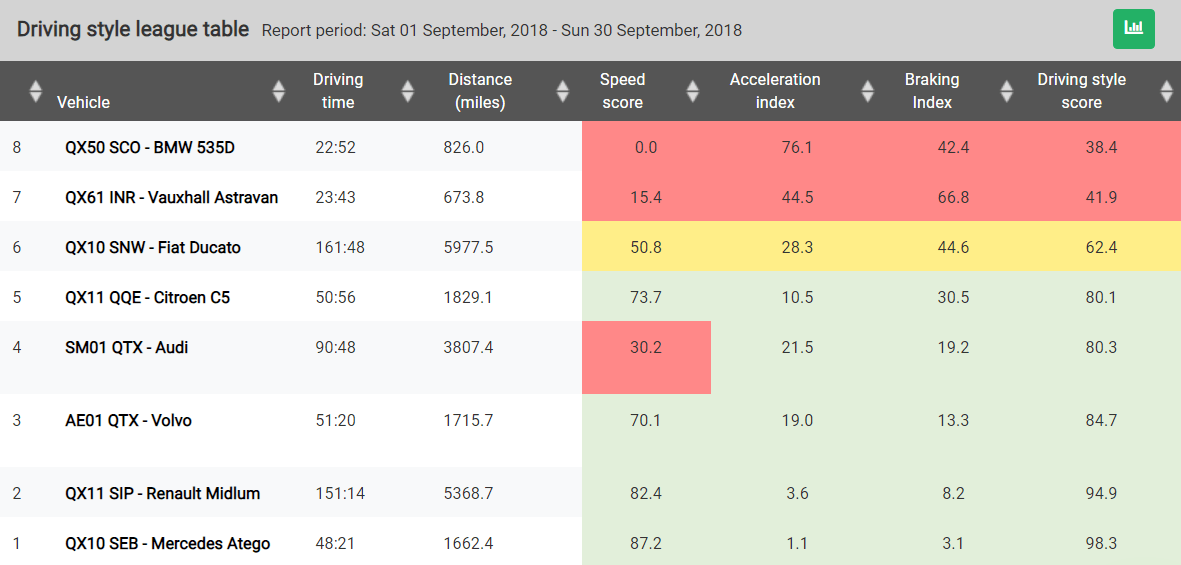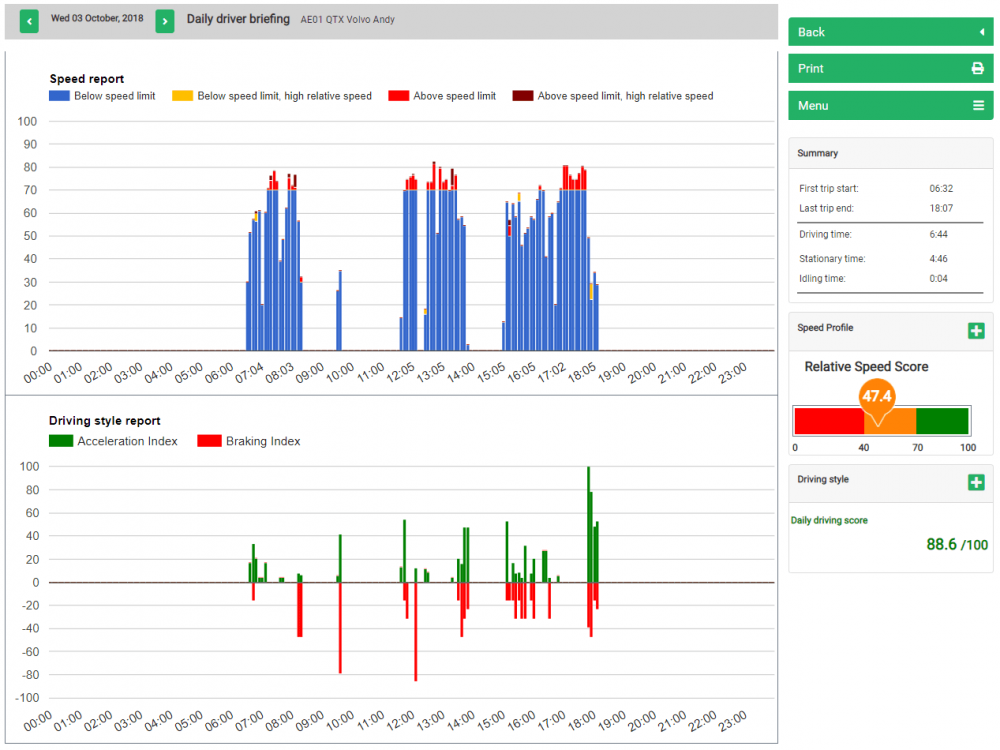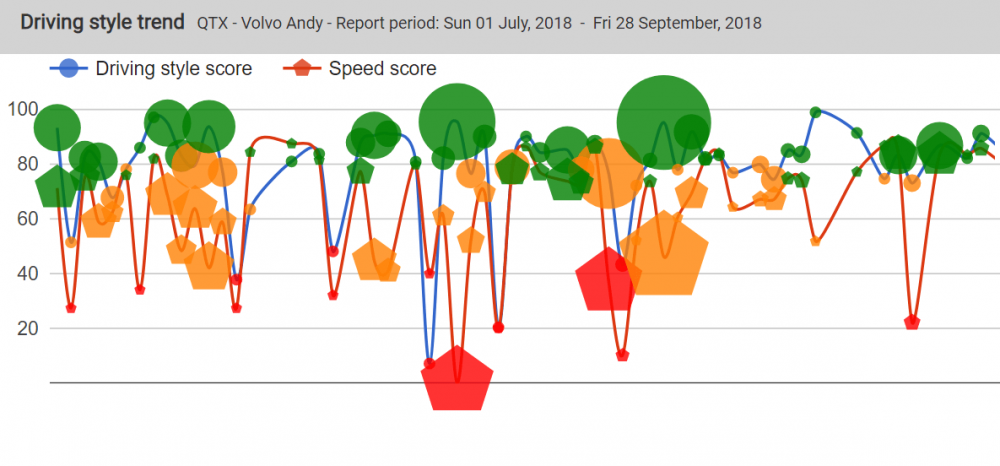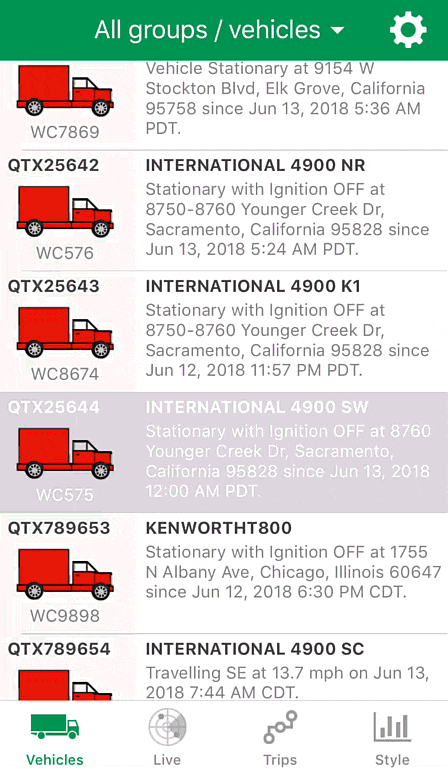Driver behaviour scores
Compare driver behavior scores across your entire fleet. Each driver is given a score based on their driving profile. Those who are taking too much risk will stand out on the Driver League Table in red. The best drivers will appear in green, and those in between will be amber.
The reports allows you to see acceleration and braking, and a simple click will take you to the exact location on Google maps where the incident took place, allowing you to investigate further.

Monitoring and improving driving style can save up to 15% in fuel savings and reduce risk of accident and injury. Training your staff to drive safely is easy with Quartix. Our range of reports, including speed distribution and acceleration / braking profiles, give you all the data you need to influence and encourage safe, economical driving behaviour.

Daily driver briefing
Work with your drivers to improve driving styles and use data to show parts of their journey where they “lost” driver points, so they can review actual data and learn from experience.
The driver briefing report shows speeds for the day plus acceleration and braking profiles. To explore in detail the actual location of speeding or harsh braking incidents, it’s simple to click on the graph bars to see the Google Street View.
- Monitor speed, acceleration and braking profiles
- Compare driver behaviour scores across a group of vehicles or the whole fleet
- Save on fuel and reduce risk of accident
Relative speed scores
A high rate of fatal accidents happen on rural roads, despite drivers rarely exceeding these roads’ legal speed limit. Quartix provides a better measurement of safe speeds for your drivers; The Relative Speed Score uses contextual data to give a complete picture of their performance.
By measuring the speed of thousands of vehicles across the country, Quartix has designed the SafeSpeed database. Any driver’s speed, at any location, can be compared to the average speed of other vehicles that have travelled on the same section of road.
The Relative Speed Score offers invaluable insight into driver safety. It allows you to coach your drivers more effectively, improve their driving behaviour and prevent accidents.

Driving style trend
Quickly identify any driving style concerns that may need immediate attention. Working with your drivers, you can identify if their style is improving over time – over the course of a month you might expect to see an impact – and incorporate this into performance reviews or reward schemes to encourage better driving.
Looking at the driving style over a month or longer, allows you to see if the style if consistent and spot any trends such as for example, specific locations or specific days where speed scores are worse.
The data can be exported into a csv file for further analysis.
Mobile App for drivers
Grant individual drivers access to their own driving style reports via the Mobile app, without giving them access to other drivers’ information. This encourages drivers to see their own scores and performance at the end of each day.
The driver will be able to see the speed they travelled at different points in the day, and they can see the acceleration and braking index for that same time period.
The Daily Driver Score is also clearly visible, so the driver can access their style of driving at the end of each day, or go back over previous days in the week to see how their driving has improved.
The app is free to download and there is no limit to the number of people who can use the app per account.

Quartix analyses each driver’s acceleration, braking and speeding patterns on every trip. Using these metrics, the system generates a driver score for each driver and vehicle . All your drivers’ scores are compiled into a Driver League Table, so you can instantly see who is driving safely (green scores) and who might be taking excessive risks (red scores). This objective scoring method gives you a clear overview of driving styles across your fleet.
Quartix provides several detailed driving-style reports. The Daily Driver Briefing report, for example, shows each driver’s speeds throughout the day alongside instances of harsh acceleration or braking . You can click on any event (such as a harsh braking incident or an over-speed occurrence) to see the exact location on Google Maps or Street View where it happened, helping you investigate and discuss it with the driver. Other reports include speed distribution charts and acceleration/braking profiles, which pinpoint where a driver lost points so you can coach them on those specific incidents.
The SafeSpeed database is a unique Quartix feature that compares your drivers’ speeds against average driving speeds on the same roads . Using this data, Quartix assigns a Relative Speed Score that factors in road context – not just legal speed limits. This means even if a driver isn’t exceeding the posted limit, you’ll know if they are driving much faster than average traffic on that route (which can be risky on twisty or rural roads). The Relative Speed Score provides a more complete picture of driver safety and helps you coach drivers to choose safer speeds for the conditions .
By highlighting risky driving habits, Quartix enables targeted driver training that can yield big benefits. Fleet managers can use the driver scores and reports to coach drivers – for instance, showing a driver exactly where they were speeding or braking harshly, and discussing how to improve. This feedback loop encourages safer driving. Safer, smoother driving not only reduces accident risk but also improves fuel economy. In fact, many Quartix customers find that monitoring and improving driving style leads to significant fuel savings (up to 15% reduction in fuel costs) and less wear-and-tear on vehicles .
Yes, if you choose to share them. Quartix has a mobile app that can be configured for drivers to access their own driving scores and reports (and only theirs) . This means an individual driver can review how they did at the end of the day – encouraging personal accountability. They cannot see other drivers’ data, which keeps the information private. By allowing drivers to monitor their own progress, you can foster a sense of competition or self-improvement, making it more likely they will adapt and improve their driving behaviour over time.

